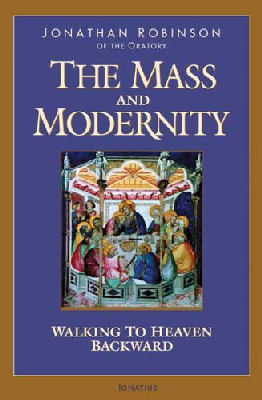
|
Posted May 9, 2006
Book: The Mass and Modernity Author: Jonathan Robinson of the Oratory Ignatius Press, San Francisco, CA, 2005. Pp. 377 An Excerpt from the Jacket:
The first aim of this book is to examine the origins and present day influence of modernity, and then to argue that there is nothing, in the Christian’s concern for the modern world that requires accepting this damaging mind-set in connection with the highest form of worship, the Mass. The second aim of the book is to show that the sources of a genuine liturgical renewal are to be found in a heightened sense of the centrality of the Mass and a return to a theology compatible with The Catechism of the Catholic Church. An Excerpt from the Book: Something has gone drastically wrong with the worship of the Church. It is important to see that this conviction, while by no means universal, is shared by traditionalists and by many who could in no way be called conservative or traditional. The Belgian primate Cardinal Danneels, who would certainly be regarded as belonging to the “progressive” wing of the Church, wrote in his diocesan newsletter: In the past Canon Law and the rubrics dominated everything: priests conformed to their prescriptions with an obedience which was sometimes puerile, for want of being enlightened. Today, the reverse is the case: it is the liturgy which must obey us and be adapted to our concerns, to the extent of becoming more like a political meeting or a “happening.” “We are going to celebrate our own life experience!” I think the Cardinal is right, and I also believe he has identified what has gone wrong: the liturgy is no longer primarily the worship of God, but a celebration of our needs and “our own life experience”. It is quite true that many, perhaps even most, people who still go to Mass are not unduly upset by this. But this satisfaction, self-satisfaction if Godfried Cardinal Danneels is right, has to be balanced with two considerations. In the first place, there is a recognition at the highest levels in the Church that something like a reform of the reform really is required; and this shows at very least that criticism of the present liturgical arrangements is not based merely on an unwillingness to change or on a contrariness that refuses to accept the behest of legitimate authority. Secondly, there is the fact that, while those who still go to Mass may be satisfied enough with the present arrangements, there has been a catastrophic falling off in attendance at Mass and in the influence of the Church. A far greater number of non-practicing Catholics and the unchurched find nothing in our rites, as currently celebrated, to draw them. Joseph Cardinal Ratzinger in a series of important books has argued that many of the ills in today’s Church are directly connected with both the way the liturgical reforms of the post-Vatican II era were implemented and the way the liturgy is celebrated today. Many liturgists and theologians disagree with what the Cardinal has to say, but I do not see how it is possible to deny that the Cardinal, as the Prefect of the Congregation for the Doctrine of the Faith, was in a unique position to see what is actually going on in the worldwide Church. If he thinks there is a problem, then most probably there is a problem. The officials of a liturgical commission in a particular diocese may tell us that everything is all right and that it is only extremists on both sides who are worried about the way things are, but it would seem the better part of rationality, if not ecclesial-political expediency, to give the Cardinal’s point of view at least a hearing: “I am convinced that the crisis in the Church that we are experiencing today is to a large extent due to the disintegration of the liturgy, which at times has even come to be conceived of etsi Deus non daretur: in that it is a matter of indifference whether or not God exists and whether or not he speaks to us and hears us.” Table of Contents: Part 1: Wingless Chickens 1. The enlightenment: daring to know 2. Latitudinarianism: giving up on revelation 3. Kant and moral religion: giving up on the Church and the sacraments 4. Hume and atheism: giving up on God and everlasting life 5. Hegel: God becomes the community 6. Comte: “policing the sublime Part Two: The Night Battle 1. Postmodernism — blowing it all up 2. The Church in society 3. Swimming against the tide Part Three: The Lamb’s High Feast 1. The Paschal mystery 2. “With desire I have desired” 3. From communal divinity to the Holy Community 4. Mr. Ryder comes to town 5. “Know what you are doing” |
|
